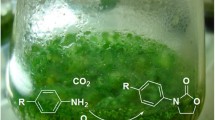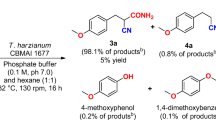Abstract
An efficient method for asymmetric reduction of (S)-3-chloro-1-phenylpropanol from 3-chloropropiophenone was developed using preheated Candida utilis cells immobilized in calcium alginate gel beads. Heating the immobilized cells (bead diameter 1.5 mm) at 45°C for 50 min allowed the reaction to proceed with 99.5% enantiomeric excess (ee) and an 85% yield with 1 g substrate l−1 (batch addition in three aliquots) in 48 h. The immobilized cells retained approximately 50% of their original catalytic activity after being reused three times.


Similar content being viewed by others
References
Davoli P, Forni A, Moretti I et al (1999) (R)-(+) and (S)-(–) Ethyl 4,4,4-trifluoro-3-hydroxy butanoate by enantioselective Baker’s yeast reduction. Enzyme Microb Technol 25(1–2):149–152
Demming S, Gautier A, Legallais C et al (2008) Solid–liquid mass transfers in an airlift reactor incorporating alginate beads for the application as a bioartificial liver. Chem Eng Process 47(12):2370–2378
Hu J, Xu Y (2006) Anti-prelog reduction of prochiral carbonyl compounds by Oenococcus oeni in a biphasic system. Biotechnol Lett 28(14):1115–1119
Novák J, Zarevúcka M, Wimmer Ż et al (2001) A comparison of the enantioselective reduction potential of five strains of Saccharomyces cerevisiae towards a selected ketone. Biotechnol Lett 23(18):1517–1522
Rossi-Alva JC, Rocha-leao MHM (2003) A strategic study using mutant-strain entrapment in calcium alginate for the production of Saccharomyces cerevisiae cells with high invertase activity. Biotechnol Appl Biochem 38(1):43–51
Shim J, Kim GY, Yeon KH et al (2007) Degradation of azo dye by an electroenzymatic method using horseradish peroxidase immobilized on porous support. Korean J Chem Eng 24(1):72–78
Srebnik M, Ramachandran PV, Brown HC (1988) Chiral synthesis via organoboranes. 18. Selective reductions. 43. Diisopinocampheylchloroborane as an excellent chiral reducing reagent for the synthesis of halo alcohols of high enantiomeric purity. A highly enantioselective synthesis of both optical isomers of tomoxetine, fluoxetine, and nisoxetine. J Org Chem 53(13):2916–2920
Suzuki T, Idogaki H, Kasai N (1999) Dual production of highly pure methyl (R)-4-chloro-3-hydroxybutyrate and (S)-3-hydroxy-γ-butyrolactone with Enterobacter sp. Enzyme Microb Technol 24(1–2):13–20
Xue MW, Yu WT, Liu XD et al (2004) Chemical method of breaking the cell-loaded sodium alginate/chitosan microcapsules. Chem J Chin Univ 25(7):1342–1346
Zhang ZM, Jin MF, Yu XJ et al (2004) Photo-hydrogen evolution by immobilized marine green algae Platymonas subcordiformis. J Chem Ind Eng (China) S1:81–85
Zheng LY, Xiao YL (2004) Penicillium sp. ZD-Z1 chitosanase immobilized on DEAE cellulose by cross-linking reaction. Korean J Chem Eng 21(1):201–205
Acknowledgements
This work was financed by the Department of Science and Technology of Zhejiang Province (China) under Project No. 2007C33047.
Author information
Authors and Affiliations
Corresponding author
Rights and permissions
About this article
Cite this article
Gen-Sheng, Y., Jiang-Yan, X., Zhi-Min, O. et al. Asymmetric reduction of (S)-3-chloro-1-phenylpropanol from 3-chloropropiophenone by preheated immobilized Candida utilis . Biotechnol Lett 31, 1879–1883 (2009). https://doi.org/10.1007/s10529-009-0084-4
Received:
Revised:
Accepted:
Published:
Issue Date:
DOI: https://doi.org/10.1007/s10529-009-0084-4




